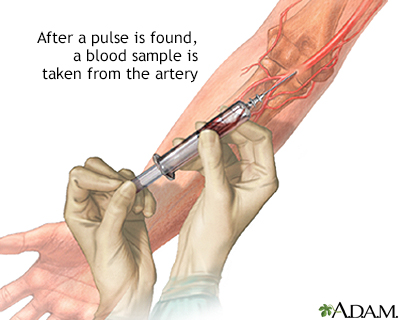Arterial stick
Blood sample - arterial
An arterial stick is the collection of blood from an artery for laboratory testing.
Images

I Would Like to Learn About:
How the Test Is Performed
Blood is usually drawn from an artery in the wrist. It may also be drawn from an artery on the inside of the elbow, groin, or other site. If blood is drawn from the wrist, the health care provider will first check the pulse. This is to make sure blood is flowing into the hand from the main arteries in the forearm (radial and ulnar arteries).
The procedure is done as follows:
- The area is cleaned with antiseptic.
- A needle is inserted. A small amount of anesthetic may be injected or applied before the needle is inserted.
- Blood flows into a special collecting syringe.
- The needle is removed after enough blood is collected.
- Pressure is applied to the puncture site for 5 to 10 minutes to stop the bleeding. The site will be checked during this time to make sure the bleeding stops.
If it is easier to get blood from one location or side of your body, let the person who is drawing your blood know it before starting the test.
How to Prepare for the Test
Preparation varies with the specific test performed.
How the Test will Feel
Puncture of an artery may be more uncomfortable than puncture of a vein. This is because arteries are deeper than veins. Arteries also have thicker walls and have more nerves.
When the needle is inserted, there may be some discomfort or pain. Afterward, there may be some throbbing.
Why the Test Is Performed
Blood transports oxygen, nutrients, waste products, and other materials within the body. Blood also helps control body temperature, fluids, and the balance of chemicals.
Blood is made up of a fluid portion (plasma) and a cellular portion. Plasma contains substances dissolved in the fluid. The cellular portion is made up mainly of red blood cells, but it also includes white blood cells and platelets.
Because blood has many functions, tests on the blood or its components may give valuable clues to help providers diagnose many medical conditions.
Blood in the arteries (arterial blood) differs from blood in the veins (venous blood) mainly in its content of dissolved gases (oxygen and carbon dioxide). Testing arterial blood shows the makeup of the blood before any of its contents are used by the body tissues.
Normal Results
Normal value ranges may vary slightly among different laboratories. Talk to your provider about the meaning of your specific test results.
What Abnormal Results Mean
An arterial stick is done to get blood samples from arteries. Blood samples are mainly taken to measure gases dissolved in the arterial blood. Abnormal results may point to breathing problems or problems with the body's metabolism. Sometimes arterial sticks are done to get blood culture (testing for infection) or blood chemistry samples.
Risks
There is little risk in having your blood taken. Veins and arteries vary in size from one person to another and from one side of the body to the other. Taking blood from some people may be more difficult than from others.
Other risks associated with having blood drawn are slight but may include:
- Excessive bleeding
- Fainting or feeling lightheaded
- Hematoma (blood accumulating under the skin)
- Multiple punctures to locate veins
- Infection (a slight risk any time the skin is broken)
There is a slight risk for damage to nearby tissues when the blood is drawn. Blood can be taken from lower-risk sites, and techniques can be used to limit tissue damage.
Related Information
Platelet countBreathing difficulties - first aid
Blood culture
References
Eiting E, Kim HT. Arterial puncture and cannulation. In: Roberts JR, Custalow CB, Thomsen TW, eds. Roberts and Hedges' Clinical Procedures in Emergency Medicine and Acute Care. 7th ed. Philadelphia, PA: Elsevier; 2019:chap 20.
Smith SF, Duell DJ, Martin BC, Gonzalez L, Aebersold M. Specimen collection. In: Smith SF, Duell DJ, Martin BC, Gonzalez L, Aebersold M, eds. Clinical Nursing Skills: Basic to Advanced Skills. 9th ed. New York, NY: Pearson; 2016:chap 20.
BACK TO TOPReview Date: 2/28/2023
Reviewed By: Jacob Berman, MD, MPH, Clinical Assistant Professor of Medicine, Division of General Internal Medicine, University of Washington School of Medicine, Seattle, WA. Also reviewed by David C. Dugdale, MD, Medical Director, Brenda Conaway, Editorial Director, and the A.D.A.M. Editorial team.

Health Content Provider
06/01/2025
|
A.D.A.M., Inc. is accredited by URAC, for Health Content Provider (www.urac.org). URAC's accreditation program is an independent audit to verify that A.D.A.M. follows rigorous standards of quality and accountability. A.D.A.M. is among the first to achieve this important distinction for online health information and services. Learn more about A.D.A.M.'s editorial policy, editorial process and privacy policy. A.D.A.M. is also a founding member of Hi-Ethics. This site complied with the HONcode standard for trustworthy health information from 1995 to 2022, after which HON (Health On the Net, a not-for-profit organization that promoted transparent and reliable health information online) was discontinued. |
The information provided herein should not be used during any medical emergency or for the diagnosis or treatment of any medical condition. A licensed medical professional should be consulted for diagnosis and treatment of any and all medical conditions. Links to other sites are provided for information only -- they do not constitute endorsements of those other sites. © 1997- 2024 A.D.A.M., a business unit of Ebix, Inc. Any duplication or distribution of the information contained herein is strictly prohibited.
